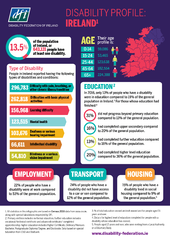DFI Infographic IRELAND
Issued on March 4 2019
Disability Profile: Ireland[1]
Population
13.5% of the population of Ireland, or 643,131 people have at least one disability.
Age
Their age profile is:
0-14 59,086
15 – 24 53,465
25 – 44 123,638
45 – 64 182,554
65+ 224,388
Type of Disability
A difficulty with pain, breathing, or any other chronic illness or condition | 296,783 |
Difficulties with basic physical activities | 262,818 |
Learning difficulty | 156,968 |
Mental health | 123,515 |
Deafness or serious hearing impairment | 103,676 |
Intellectual disability | 66,611 |
Blindness or a serious vision impairment | 54,810 |
Education[2]
In 2016, only 13% of people who have a disability were in education compared to 19% of the general population in Ireland.[3] For those whose education had finished:[4]
- 31% did not progress beyond primary education compared to 13% of the general population.
- Only 16% had completed upper secondary compared to 20% of the general population.
- Only 13% had completed further education compared to 16% of the general population.
- Only 20% had completed higher level education compared to 36% of the general population.
Employment
- 22% of people who have a disability were at work compared to 53% of the general population.
Transport
- 24% of people who have a disability did not have access to a car or van compared to 12% of the general population.
Housing
- 15% of people who have a disability lived in social housing compared to 9% of the general population.[5]
[1] All statistics in this infographic are based on Census 2016 data from www.cso.ie, along with special tabulations requested by DFI.
[2] Primary and less includes no formal education, further education includes vocational/technical certificate and advanced certificate/ completed apprenticeship, higher education includes Higher Certificate, Ordinary/Honours Bachelor, Postgraduate Diploma/Degree, and Doctorate. Data based on special tabulation from CSO and Statbank.
[3] % of total education ceased and not ceased and for people aged 15 years and over.
[4] Data is for highest level of education completed for people with a disability whose education has ceased.
[5]People aged 15 years and over, who were renting from a Local Authority or a Voluntary Body.
|

